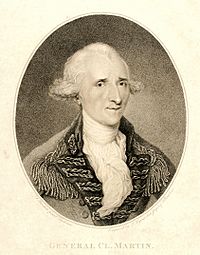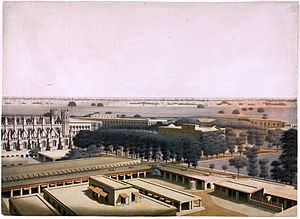Claude Martin facts for kids
Quick facts for kids
Claude Martin
|
|
|---|---|

General Cl. Martin (1794), published in Lucknow, after an original by Renaldi, engraved by L. Legoux- Late pupil of F. Bartolozzi.
|
|
| Born | 5 January 1735 |
| Died | 13 September 1800 (aged 65) Lucknow, Oudh State
|
| Resting place | Constantia- La Martiniere Lucknow |
| Monuments | Farhad Baksh Kothi (Chateau de Lyon), Bibiapur Kothi, Hayat Baksh Kothi and Constantia |
| Occupation | Soldier |
| Organization | East India Company |
| Parents |
|
| Signature | |
Major-General Claude Martin (born January 5, 1735 – died September 13, 1800) was a brave French army officer. He served in both the French and later the British East India Company in colonial India. Martin rose to a high rank, becoming a major-general in the British East India Company's Bengal Army. He was born in Lyon, France, into a simple family. Claude Martin was a self-made man who achieved great success. He left behind a huge legacy through his writings, the amazing buildings he designed, and the schools he started after his death. Today, ten schools are named after him: two in Lucknow, two in Calcutta, and six in his hometown of Lyon. A small village in India, Martin Purwa, is also named in his honor.
Claude Martin's Amazing Life
Becoming a Soldier and Leader
Claude Martin was born in Lyon, France, on January 5, 1735. His father, Fleury Martin, was a casket maker, and his mother, Anne Vaginay, was a butcher's daughter. From a young age, Claude was very good at math and science in school. After school, he started working as a silk weaver.
In 1751, when he was just 16, Martin decided to seek adventure abroad. He joined the French Compagnie des Indes, a trading company with its own army. He was sent to India and fought in the Carnatic Wars against the British East India Company. When the French lost their colony of Pondichéry in 1761, Martin decided to join the Bengal Army of the East India Company in 1763. He eventually became a Major General.
He first worked at the new Fort William in Calcutta. Later, he helped survey the land of Bengal. In 1776, Martin was asked to become the Superintendent of the Arsenal for the Nawab of Awadh, Asaf-ud-Daula, in Lucknow. He kept his military rank but was paid less. He lived in Lucknow from 1776 until he died. Martin never officially gave up being French, but he wanted to become a full British officer later in his life.
A Skilled Architect and Builder
Growing up in Lyon, a city known for its beautiful buildings, Martin developed a great eye for architecture. His skills were highly valued in Lucknow. His close friendship with Nawab Asaf-ud-daula gave him a special chance to help build modern Lucknow. Martin moved to Lucknow around the same time the Nawab made it his capital. Together, they became the main architects of the city.
Raj Bhavan, which means 'Government House' in Hindi, is the official home of the governor of Uttar Pradesh. It used to be called Kothi Hayat Baksh. Major General Claude Martin designed the building in 1798. The new ruler, Sadaat Ali Khan, loved Martin's designs. Martin was given the job to build the Kothi.
Some of Lucknow's famous buildings that show Martin's unique style include: Farhad Baksh, Asafi Kothi, Bibiapur, Barowen, and of course, the amazing Constantia. Many of Martin's buildings were unique. Other designers often copied his ideas, especially his defensive features against military attacks.
A Collector of Fine Things
While working for the Nawab Asaf-Ud-Dowlah of Awadh, Martin became very wealthy, earning about 4,000,000 rupees. He built the grand palace of Constantia and his beautiful home, Farhat Baksh. He filled these homes with luxurious items. This included a library of about 4,000 books in many languages. He also had an art gallery with a wonderful collection of paintings. When he died, Claude owned over 650 Company style paintings of birds. These were painted by artists trained in the Mughal style. One famous painting, Black Stork in a Landscape, is now in the Metropolitan Museum of Art in New York.
Martin loved art, which was clear from his collection and the design of his homes. He was friends with famous artists like Renaldi, Hodges, and Zoffany. Zoffany even included Martin in at least two of his paintings. Martin often hired local artists to create works in the style of European art. His walls had decorations like ancient Greek designs. His paintings were by Indian artists, and the statues at his palace were clever copies of European ones.
All the furniture and treasures from Constantia and Farhat Baksh were sold after his death, as he had wished. The large chandeliers were bought for the Government House in Calcutta, where they still hang today. Most of his collection was sold to private buyers.
A Wealthy and Influential Nawab
During his time in Lucknow, Martin became very rich and powerful. He was in charge of the state's weapons, designed and built many buildings, and owned large areas of land. This made Martin a very important person in Lucknow society. He enjoyed his role as a nawab, a title given to powerful local rulers.
He hosted many parties for both British and Indian nobles. He actively took part in the social and cultural life of Lucknow. He had a city home called Farhat Baksh and a country palace, Constantia. He also owned other properties in Lucknow, Kanpur, Bhazipur, and Benaras. These properties gave him a lot of income. From his will, we know he was a kind boss who cared about his staff and servants.
A Smart Banker and Businessman
Claude Martin was a very clever businessman with many different interests. He was known for his financial skills. People said he didn't chase money; he made money come to him. Part of his huge fortune came from the bank he started in Lucknow. He loaned money to the Nawab of Awadh. His biggest loan was about £250,000 in 1794, which he had some trouble getting back.
Martin quickly saw how important indigo farming was. He invested in this profitable business in several parts of North India. He exported indigo and cloth to Europe, and in return, he received Spanish dollars. Martin also started a cannon factory, used a Dutch method to cut diamonds, made gunpowder, and even minted his own rupees (Indian currency).
An Amateur Scientist and Doctor
Besides being a self-made man, Martin was also an amateur scientist and a kind of doctor. He suffered from bladder stones. In 1782, despite terrible pain, he successfully tried a very early and unusual way to break the stones. This method is now called lithotripsy. Martin sent details of his operation to the Company of Surgeons in London. Even though some surgeons were doubtful at first, his operation is now seen as the first recorded one of its kind.
A Pioneer in Hot Air Balloons

Claude Martin was interested in many things, including hot air balloons. He helped introduce a Montgolfier hot air balloon to the Nawab and other important people in Lucknow in 1785. This was less than two years after the first successful flight in France!
A Generous Philanthropist
Martin was a very kind and charitable person. This is clear from his last will and testament. He wrote:
"I give and leave the sum of one hundred and fifty thousand rupees to be invested safely. The interest from this money should be used for the poor. This interest should be divided into three parts: one for the poor of Lucknow of any religion, one for the poor of Calcutta, and one for the poor of Chandernaggur."
A Founder of Schools
Among all the European adventurers in India, Claude Martin is unique. He left most of his wealth to various charities. Since he was mostly self-educated, he understood how valuable formal education was. He willed a large part of his fortune to create three schools. These schools are in Calcutta, Lucknow, and his hometown of Lyon in France. All three are named La Martiniere College. All three schools celebrate Founder's Day on September 13, the anniversary of Martin's death.
Martin's will did not mention any restrictions on who could attend his schools based on their background or religion. However, after many years, the La Martiniere College in Calcutta initially only allowed European and Armenian Christian students. This changed over time, and by 1935, Indian students of all religions were allowed to apply.
See also
- The will of Claude Martin
- La Martiniere College
- La Martiniere Calcutta
- La Martiniere Lucknow
- La Martiniere Lyon
- Martinians
- Martin Purwa
- Claude Martin Wade – A Colonel named after Claude Martin
Images for kids
-
A painting by Johan Zoffany showing Boulone Lise and James Martin.





